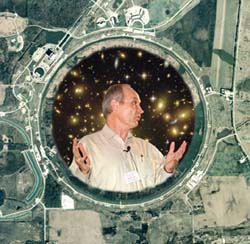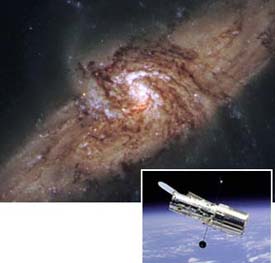 |
|
Why Accelerators Matter A cosmologist's assessment: The universe is not enough
by Michael S. Turner For two decades, I have been an advocate for using the universe as a heavenly laboratory to extend our experimental reach in addressing some of the most exciting questions in science. Indeed, experiments using beams of neutrinos from the sun, a distant supernova and cosmic-ray collisions in Earth's atmosphere have taught us much about the properties of neutrinos, including the first solid evidence for neutrino mass. Yet, in making the case for nonaccelerator physics, I (and others) may have been too successful. Accelerators are also crucial to realizing the opportunities to dramatically advance our understanding of the universe and the laws that govern it. Not only can accelerators reveal much about the fundamental particles and forces, but also they can make discoveries that are critical to understanding the cosmos. While the heavenly lab offers enormous dynamical range in energy, density and other parameters, accelerators offer well-planned experiments under carefully controlled conditions. The first evidence for neutrino mass came by way of beams of heavenly neutrinos; but only by using accelerator neutrino beams of well-determined energy, flux and flavor content will we be able to sort out the pattern of neutrino masses and get at the question of CP violation. In addition to the clues that this knowledge will give us about the unification of the forces, we all have a more personal interest: It now seems quite possible that neutrino mass and CP violation played a role in creating the excess of quarks over antiquarks that led to stars, and ultimately, to the stuff like us that came from them. SAKHAROV, DARK MATTER AND PARTICLE SOUP In 1967, Andrei Sakharov gave a seminar that left his colleagues scratching their heads. He explained how CP violation, baryon number nonconservation and the early rapid expansion of the universe could conspire to produce an excess of baryons over antibaryons, leaving the baryons we are made of when the universe cooled and all the antimatter and most of the matter annihilated. Today, Sakharov's crazy idea is the working hypothesis for why our baryons exist in the here and now, and it has evolved to include a role for neutrinos! Only accelerator experiments will shed light on the CP violation piece of his recipe. "Cosmology and particle physics are now joined at the hip by a new set of profound questions," says Michael Turner, "whose asking and answering cannot be neatly partitioned into physics and astronomy."

On to darker matters. Cosmologists have put forth a compelling case for a remarkable idea: the dark matter whose gravity holds together all structures in the universe, from our own galaxy to distant superclusters, is composed of elementary particles left over from the earliest moments. The lightest supersymmetric particle—the neutralino, whose mass is supposed to be a hundred times that of a proton—is the prime dark-matter suspect. (Neutrinos are a part of the cosmic mix, but account for at most 10 percent of the dark matter.) Before the neutralino is discovered at the Tevatron or LHC, I am rooting for a cryogenic dark-matter detector (like Fermilab's CDMS II operating in the Soudan Mine) to announce that a swarm of neutralinos holds the Milky Way together. But I also know that producing and studying neutralinos with accelerators is an indispensable part of the plan if we are to truly understand how neutralinos fit into the grander scheme of things. In 1970, when cosmology was stalled, discoveries made at accelerators propelled it into the current renaissance. The discovery of the cosmic microwave background radiation in 1965 told us the universe began as a hot particle soup; however, our then ignorance of quarks and gluons erected a brick wall at 10 microseconds. If the fundamental particles are the finite-sized neutrons, protons and other hadrons, the universe had a confusing beginning with overlapping particles and a maximum temperature of only 100 MeV (due to the exponentially rising number of hadron states). The emergence of the standard model of particle physics in the late 1970s opened the door to the study of the earliest moments of the universe, when temperatures reached as high as 1019 GeV. Almost immediately, the driving ideas in cosmology today—inflation, dark matter, and Sakharov's "baryogenesis"—came to be. If quarks, leptons and gauge bosons are point-like and weakly interacting, the early universe is then no harder to understand than a dilute, hot plasma–provided, of course, that you have in hand all the hard-won knowledge about quarks, leptons and gluons that has come from accelerator experiments. ACCELERATORS AND TELESCOPES
I would not even rule out accelerators teaching us something profound about dark energy, that diffuse, mysterious stuff whose only known effects are to: (a) cause the speed-up of the expansion of the universe; and (b) keep me awake at night trying to figure out what it is. The fields of cosmology and particle physics have been drawn together by advances in both, made possible by telescopes and accelerators. Cosmology and particle physics are now joined at the hip by a new set of profound questions, whose asking and answering cannot be neatly partitioned into physics and astronomy. Answering these questions will lead to a quantum leap in our understanding of the universe, of the laws that govern it and even of our place within it. To realize this opportunity of a lifetime, we will need both accelerators and telescopes, and that's why accelerators matter. ON THE WEB: Respond online at: www.fnal.gov/pub/ferminews/interactions/index.html or send email to ferminews@fnal.gov |
| last modified 7/7/2003 email Fermilab |
FRLsDFx9eyfrPXgV
 It is easy to predict that further progress in
understanding the universe’s origin, its evolution
to its present state, and its ultimate destiny, will
involve accelerator experiments that teach us more
about nature’s deepest inner workings. Consider
just a few of the questions that accelerators are
poised to answer, which are also central to
cosmology:
It is easy to predict that further progress in
understanding the universe’s origin, its evolution
to its present state, and its ultimate destiny, will
involve accelerator experiments that teach us more
about nature’s deepest inner workings. Consider
just a few of the questions that accelerators are
poised to answer, which are also central to
cosmology: